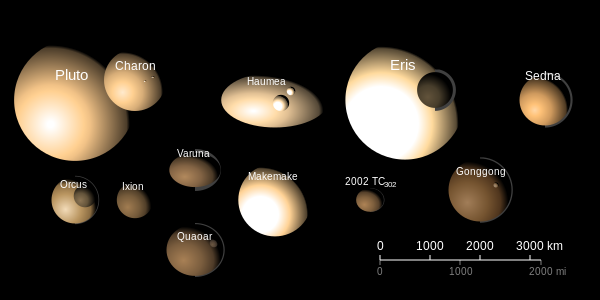Dwarf Planet

A new term adopted by the International Astronomical Union (IAU) in 2006[1] in order to classify a celestial body orbiting the Sun with sufficient size and gravitational pull to be round in shape, but not sufficient to clear its immediate region of other small bodies besides any moons it might have. A planet has sufficient gravitational pull both to be round and to cause most small bodies to fall into it or to orbit around it over time, a process known as "clearing its orbit"[2]
As a result of this definition, the IAU no longer considers Pluto to be a planet, thus reducing the count of known planets in our solar system to eight.
The impetus to name a new class of heavenly bodies orbiting the sun began in the early 2000s, with the discovery of new bodies located beyond Neptune, and close to Pluto in size, yet with gravitational properties different from the "true" planets. Pluto seemed to behave more like the other Trans-Neptunians than it did like the planets closer to the sun in orbit.
Eris was discovered beyond Pluto in 2005. It seems a bit larger than Pluto, and has its own moon, Dysnomia. Named for the goddes of strife, Eris generated disagreement among astronomers as to what should be called a planet, and whether a new classification might be more accurate.

Astronomy
Currently, the IAU classifies only five objects in our solar system as dwarf planets: Ceres in the asteroid belt, and the "plutoids" Pluto, Haumea, Makemake, and Eris in the Kuiper Belt. The other large bodies in the asteroid belt, Vesta, Pallas and Hygiea, remain classified as asteroids, yet designations can change as astronomers learn more about their properties.
Astrology
Dwarf planet is currently an astronomical definition that has no impact on astrology to date: in fact planets in astrology include the Sun, the Moon and, for some astrologers, Ceres, Pallas, Juno, Vesta and Chiron, although astronomers consider none of these to be a planet. Thus Pluto is still considered a planet in astrology.
Weblinks
- Wikipedia: Dwarf planet
- How many dwarf planets are there in the outer solar system? (astronomer Michael Brown, daily updates)
- Pluto and the Developing Landscape of Our Solar System (IAU, 2013)
- The Centaur Research Project (Robert von Heeren)
- philipsedgwick.com (Plutoids, Eris, Sedna, Centaurs & Kuiper Belt Objects)
Notes and References
- ↑ BBC News: Pluto loses status as a planet (Prague on August 24th 2006, 13:34 GMT)
- ↑ Resolution of the IAU (PDF)
- ↑ French: Hector Servadac (1877) drawn by Paul Dominique Philippoteaux